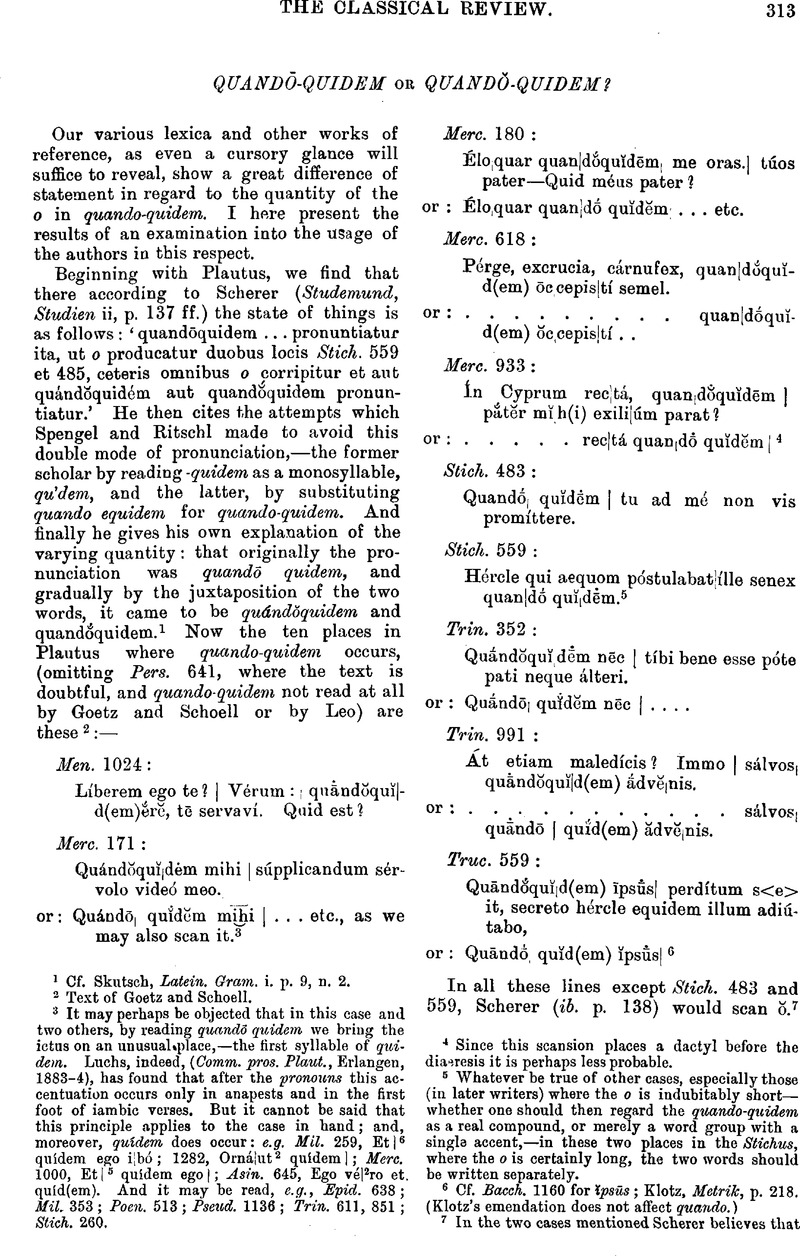No CrossRef data available.
Article contents
Quandō-Quidem or Quandŏ-Quidem?
Published online by Cambridge University Press: 27 October 2009
Abstract

- Type
- Original Contributions
- Information
- Copyright
- Copyright © The Classical Association 1903
References
page 313 note 1 Cf. Skutsch, , Latein. Gram. i. p. 9, n. 2.Google Scholar
page 313 note 2 Text of Goetz and Schoell.
page 313 note 3 It may perhaps be objected that in this case and two others, by reading quandō quidem we bring the ictus on an unusual place,—the first syllable of quidem. Luchs, indeed, (Comm. pros. Plaut., Erlangen, 1883–4), has found that after the pronouns this accentuation occurs only in anapests and in the first foot of iambic verses. But it cannot be said that this principle applies to the case in hand; and, moreover, quídem does occur: e.g. Mil. 259, Et |6 quídem ego i|bó; 1282, Orná|ut2 quídem |; Merc. 1000, Et | 5 quidem ego |; Asin. 645, Ego vé|2ro et. quíd(em). And it may be read, e.g., Epid. 638; Mil. 353; Poen. 513; Pseud. 1136; Trin. 611, 851 Stick. 260.
page 313 note 4 Since this scansion places a dactyl before the diaeresis it is perhaps less probable.
page 313 note 5 Whatever be true of other cases, especially those (in later writers) where the o is indubitably short—whether one should then regard the quando-quidem as a real compound, or merely a word group with a single accent,—in these two places in the Stichus, where the o is certainly long, the two words should be written separately.
page 313 note 6 Cf. Bacch. 1160 for ĭpsūs; Klotz, , Metrik, p. 218Google Scholar. Klotz's emendation does not affect quando.)
page 313 note 7 In the two cases mentioned Scherer believes that the force of the ictus kept the ō long, and he cites the early date of the Stichus (200 B.C.) as substantiation for this, although in his opinion, of course, even with the ictus, the ō did not continue to hold its quantity down to the time of Plautus's death.
page 314 note 1 This is in accord with the rule ordinarily laid down: e.g. Klotz, p. 41, fin.
page 314 note 2 To present fairly both sides of the case, it should perhaps be noted that even on the assumption that quando and quidem are separate words, it is still possible to read quandŏ in all the doubtful lines. The same statement applies to all the cases in Terence.
page 314 note 3 Müller's conjecture for Rud. 1182 (see Plaut. Pros. p. 587) also has to be scanned quandō-quidem to avoid hiatus.
page 314 note 4 P. 139; cf. Fairclough, Andr. Introd. § 53 fin.
page 314 note 5 For quídem cf. Ad. 293: Pól is |2 quídem iam hic |; 469 | 3 nam hoc quídem |; Andr. 803 |3 Nos quídem |; Haut. 707 | 5 tu quídem illum.
page 314 note 6 Except in the cases of Plautus and Terence and two or three other authors, I have thought it scarcely advisable to try to make my collections of instances exhaustive by reading the authors through, but I have simply used the best indices obtainable.
page 314 note 7 In Turpilius 158, Scherer (p. 143) suggests quandắquidem for quando, équidem. Equally well quandṍ quidem.
page 314 note 8 Or, Quándoquidem res|périit (L.).
page 314 note 9 Phaedrus's metrical usage supports the former (v. Hayley, Lane's Gram. 2595),
page 315 note 1 From Reichenhart, Die Conjunctionen bei Lucr., p. 11.
page 315 note 2 ‘quándŏqui|dém citi|us| fáta do[l.' Cf. Bücheler's note.
page 315 note 3 Si-quando (with ne quando) and ecquando separately below.
page 315 note 4 On Plant. Stich. 723, see Scherer, ib. p. 114. The lists which follow make no pretence of including all the occurrences of quando and its compounds Latin poetry.
page 315 note 5 Klotz, , Altröm. Metrik, p. 52Google Scholar, says: ‘… bei Plantus und Terenz einzelne Eudsilben ancipites sind, wie quandō…,’ a statement that is misleading, inasmuch as a sure case of quandŏ does not occur. Künner's statement (Gr. i. § 15, 8):—‘bei Dichtern der nachaugusteischen Zeit…quandŏ, aliquandŏ (vorher überall mit -ō)’ —though incomplete, is preferable.
page 315 note 6 Cf. Wackernagel, Ind. Forsch. 1, 414.
page 315 note 7 In Plaut. Stick. 201, A gives si quando, but this is not read in the editions.
page 316 note 1 Both late: Venantius C. 4, 27, 22, quandŏque, (but he writes at the end of the sixth century, and is notoriously irregular in metrical matters, T. Teuffel, § 491, 10); Terentianus Maurus, de Syl. 957, quandŏcumque.
page 316 note 2 Lucil. 30, 70, although possibly this is et quando (Scherer, ib. p. 136).
page 316 note 3 Petron. c. 133 (verse).
page 316 note 4 The fact that ō long persists in this word, while becoming short so much earlier in quandoquidem, would possibly militate somewhat against Stowasser's etymology for the latter word (Zeit. Oestr. Gym. 1892, p. 31 ff.), quandoquidem = quandoque, (quandoc) + dem. But obviously this point cannot be pressed.
page 316 note 5 Cf. Bücheler 966,1, a similar line, but metrically imperfect.
page 316 note 6 Latin Language, p. 608, fin.; cf. his Captivi, Introd. p. 25; and his article in J. Phil 21, 199; and Bücheler, Archiv. 3, 145. Scherer's comparison ib. p. 138) to nesciŏ-quis is obviously not so good.
page 316 note 7 Cf. Forcellini, s.v. quandoque, c), fin.
page 316 note 8 E.g. cf. Stedding's procedure in another matter, Bezzenberger's Beiträge, 27, 1.




